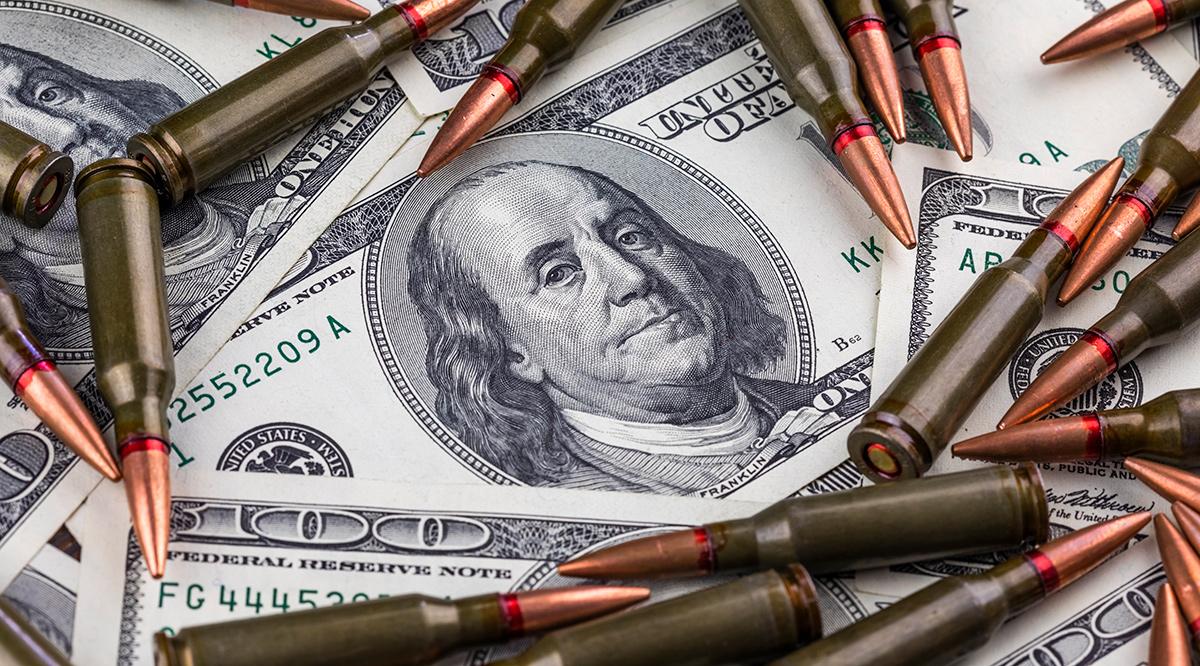On what had been a happy day in February 2014, 13-year-old DeAndre Knox was attending a birthday party at a friend’s home in Indianapolis when a stray bullet ripped through a window and struck him in the head.
At a hospital, the internal bleeding was so excessive that “the left side of his skull had to be removed in order for his brain not to erupt,” recalls his mother, DeAndra Dycus. “Months later, he had surgery to have part of his skull replaced and had a tube placed in his head to drain his cranial fluids.”
DeAndre lived — but eight years later, he cannot walk or talk. His ongoing struggles have included multiple hospitalizations and surgeries, physical and mental therapy, and bouts of pneumonia stemming from the progression of lung injuries.
“Life never goes back to the way it was,” Dycus said recently after visiting her son at a hospital near their home, where he was being treated for a particularly devastating case of pneumonia. She says the total cost of his care is in the millions; the psychological toll is incalculable.

DeAndre is among the more than 80,000 people who each year survive firearm-related injuries — more than double the 40,000 who are killed by gunshots annually, according to studies including a 2020 report led by researchers at the University of Pennsylvania Perelman School of Medicine (PSOM).
“Most of what we hear related to the gun violence epidemic in this country is centered around deaths. There’s relatively little attention paid toward survivors of firearm injuries,” notes Zirui Song, MD, PhD, associate professor of health care policy and medicine at Harvard Medical School, who has studied the cost of gun injuries. “The connotation is that the people who did not die are generally okay. We tend to forget about them.”
Many are not okay. While some are treated quickly in emergency departments (EDs), perhaps getting a flesh wound stitched, others face significant, costly, and sometimes painful medical procedures spanning months, years, or lifetimes. Some must forever cope with damaged organs, impaired or removed limbs, chronic pain, or psychological trauma.
“The injuries and the long-term morbidity affect the patients, their families, and society,” says Chadd Kraus, DO, DrPH, FACEP, an emergency physician and researcher at Geisinger Health System in Pennsylvania, who has studied the types of injuries and care resulting from mass shootings.
Cost calculations
Getting and analyzing detailed data about gun injuries in the United States is particularly difficult. For starters, there is no government database of firearm incidents nationwide — unlike those databases designed to provide details about every plane accident and every fatal motor vehicle accident. For nearly 25 years, Congressional spending bills provided no dedicated federal funds to study gun injuries, until 2019, leading to several new projects that are limited in scope.
In addition, the expenses for any individual patient are difficult to fully track, not only within a hospital system but especially across various providers outside of hospitals, including primary care doctors, specialists, home health aides, and therapists.
“We’re functioning in a data-limited zone,” says Thomas Weiser, MD, MPH, a trauma surgeon and clinical associate professor of surgery at Stanford Health in California.
The existing data do show that while self-harm is the leading cause of firearm deaths in the United States, most gun injuries (fatal and nonfatal combined) are caused by assaults and accidents. Researchers have used various records, such as databases of insurance payments and ED visits, to dig deeper into the financial impact of those injuries. Among their findings:
Initial costs are high. Immediately after shootings, most victims are treated only in the ED: about 50,000 a year, according to the U.S. General Accountability Office (GAO). Another 30,000 are admitted for inpatient treatment.
ED care for firearm-related injuries averages $1,500 per patient, while initial care for those admitted as inpatients averages $31,000, which produces an annual total of $1 billion in initial medical costs, according to a 2021 GAO report. “This is likely a significant underestimate,” the report says, because the calculations do not include some expenses that are not tracked in patient discharge data.
One study that looked specifically at more than 704,000 people who arrived at EDs with firearm-related injuries found much higher costs. The study by Johns Hopkins Medicine in Maryland, covering 2006 through 2014, found average per-patient ED charges of $5,254 a year, and inpatient charges of $95,887, adding up to $2.8 billion annually.
Costs keep mounting after initial care. A study of survivor care published in June, conducted by Song and fellow researchers at Harvard Medical School and Massachusetts General Hospital, found that medical spending for gunshot victims increased by an average of $30,000 during the first year after the injury — four times higher than concurrent medical spending in a control group of patients without firearm injuries. With about 85,000 firearm injury survivors each year, that comes to $2.5 billion in extra spending for survivors in the first year, the study found.
Dealing with ongoing physical and psychological pain creates ongoing expenses. The study found that during the year after a shooting injury, survivors (compared with the control group) “had a 40% increase in pain diagnoses, a 51% increase in psychiatric disorders, and an 85% increase in substance use disorders … accompanied by increased pain and psychiatric medications.”
The pain extends to family members. Dycus says she and her other son have periodically received mental health care related to DeAndre’s condition. “When your loved one survives, you’re on a roller coaster of emotions,” she says. “You have hope and faith for his survival, then that’s taken away” when his condition deteriorates.
Readmissions are another significant cost. The GAO report says that up to 16% of survivors with an initial inpatient stay were readmitted at least once because of the injury, with average costs of $8,000 to $11,000.
The firearm type and shooter intent affect the severity of injuries. A study led by the College of Public Health at the University of Iowa found that the most expensive average admission costs were for “legal interventions,” mainly as shootings by police ($33,462 per admission), and shootings with assault weapons ($32,237), while the lowest cost was for unintentional injuries ($16,975).
Injuries from mass shootings are especially severe and costly. Mass shootings account for a minority of gun-related injuries, but the medical costs for those injuries average $64,976 per person, according to a study published in May by Kraus and other researchers from EDs and trauma services across the country. The study looked at 403 patients from 13 incidents over seven years. It included all injuries, such those sustained by falling while fleeing the gunshots, as well as health care use after initial treatments.
Costs go beyond medical care. The medical expense estimates don’t reveal the full costs of firearm injuries, because expenses are also borne by other institutions involved in the cases, such as police departments, justice systems, social services, and employers. “Firearm injuries cause ripples of costs way outside the health system,” says Corinne Peek-Asa, MPH, PhD, who was lead author of the Iowa study on firearm types and shooter intent and is now vice chancellor for research at the University of California San Diego (UCSD).
A study released in July by Everytown for Gun Safety estimated that gun violence produces “an economic consequence” of $557 billion a year, including long-term medical care, criminal justice system resources, lost wages, lower worker productivity, and diminished quality of life for victims and their families.
Implications for providers and policymakers
The expenses for treating gunshot survivors are spread out among people and institutions, and some of the expenses never get paid.
A study published in 2019 by researchers at Stanford Health (including Weiser), looking at six years of patient data, found that the government takes on almost half of all hospital expenses. Out of $5.47 billion in costs during the study period, Medicaid and Medicare paid $2.5 billion, while private insurance and self-paying patients each accounted for $1.1 billion.
Dycus says one expense “I’ll never forget” came on a statement from her insurance company showing what it was charged by a company that airlifted DeAndre from a rehabilitation center to a hospital to treat a medical emergency: $75,000.
What happens when patients don’t have insurance? In the Johns Hopkins Medicine study that looked an initial ED and inpatient care, researchers noted that more than half of the 704,000 patients studied were uninsured or self-paying. That often left hospitals to absorb the expenses as uncompensated care.
Researchers studying the financial impact of gun injuries hope their findings can help spur the development of strategies and policies to reduce and better treat the injuries.
The findings provide “evidence to support a business case for reducing gun violence,” says Peek-Asa at UCSD.
“Your taxes, my taxes, are used to pay for the injuries to these patients,” says Weiser, noting that most of the costs are borne by the federal and state governments, which jointly fund Medicaid. “The state has a vested interest in understanding the financial implications of policies” around firearms.
The researchers stress that their call to reduce gun injuries is not a call to ban guns. In fact, Peek-Asa and Kraus are gun owners.
“I live in rural Pennsylvania, where gun ownership is common, including among physicians.” Kraus says. “I think of the implications of this research in terms of harm and risk reduction.”
Reducing the risk of firearm injuries could include policies that involve manufacturing, marketing, and storing weapons, training gun owners, and defining who has access to the weapons that cause the most severe and expensive injuries, the researchers say.
As for providers, the researchers hope that knowing about the type of physical and mental health care that firearm injury survivors and their families need can enable hospitals and doctors to better prepare for and coordinate that care.
“That can mean putting resources into programs for survivors and family members of survivors to head off the downstream consequences of nonfatal firearm injuries,” Song says. “Such as better coordination between primary care and mental health care, so that when we take care of a firearm injury survivor, it’s not just about the physical wounds. And it could mean better coordination with other specialists.”
The September issue of JAMA focuses significantly on firearm injuries, with viewpoint articles that call for a national data system to track injuries and deaths; for academic medical centers to step up efforts to address firearm violence; for businesses to get more involved in reducing gun violence for employee health and corporate financial reasons; and more.
Knowing the impacts of gun violence firsthand, Dycus has become an activist to help victims and educate the public. She volunteers with Moms Demand Action, founded and directs Purpose 4 My Pain, a resource hub to support families affected by gun violence, and created and leads an advocacy and support program in the Indianapolis Metropolitan Police Department for nonfatal shooting and violence survivors.
Her main message to society: “Injured lives matter. Don’t forget about them just because they lived.”

